
This article is reproduced from the WeChat public account "Youerhut", author Youerhut. To reprint this article, please contact the Youerhut public account.
Hello everyone, I am Peter~
I recently obtained a piece of IC electronic product e-commerce data, and will conduct data analysis and mining on 3 topics later:
This article is the first stage, the main content includes:

import pandas as pd import numpy as np import time import os from datetime import datetime import matplotlib.pyplot as plt import seaborn as sns %matplotlib inline #设置中文编码和负号的正常显示 plt.rcParams['font.sans-serif']=['SimHei'] plt.rcParams['axes.unicode_minus']=False import plotly_express as px import plotly.graph_objects as go import missingno as ms from sklearn.cluster import KMeans from sklearn.preprocessing import MinMaxScaler
df = pd.read_csv(
"ic_sale.csv",
encoding="utf-8",# 指定编码
cnotallow={"order_id":str,"product_id":str,"category_id":str,"user_id":str} # 指定字段类型
)
df.head()
# 1、数据shape df.shape
(564169, 11)
# 2、数据字段类型 df.dtypes
event_timeobject order_idobject product_idobject category_id object category_code object brand object pricefloat64 user_id object ageint64 sex object local object dtype: object
# 3、数据描述统计信息 df.describe()
| ##age | ||||
| 564169.000000 | 564169.000000 | |||
##208.269324 | ##33.184388 | std | 304.559875 | 10.122088 |
min | 0.000000 | 16.000000 | ||
25% | 23.130000 | 24.000000 | ||
50% | 87.940000 | 33.000000 | ||
75% | 277.750000 | 42.000000 | ||
max | 18328.680000 | 50.000000 |
In [6]:
# 4、总共多少个不同客户 df["user_id"].nunique()
Out[6]:
6908
In [7]:
# 5、总共多少个不同品牌 df["brand"].nunique()
Out[7]:
868
In [8]:
# 6、总共多少个订单 df["order_id"].nunique()
Out[8]:
234232
In [9]:
# 7、总共多少个产品 df["product_id"].nunique()
Out[9]:
3756
从描述统计信息中发现price字段的最小值是0,应该是没有成交的数据;我们选择price大于0的信息:
In [10]:
df = df[df["price"] > 0]
In [11]:
df.isnull().sum()
Out[11]:
event_time0 order_id0 product_id0 category_id 0 category_code129344 brand 27215 price 0 user_id 0 age 0 sex 0 local 0 dtype: int64
可以看到缺失值体现在字段:
In [12]:
ms.bar(df,color="blue")# 缺失值可视化 plt.show()

In [13]:
df.fillna("missing",inplace=True)In [14]:
df.isnull().sum()# 填充之后无缺失值
Out[14]:
event_time 0 order_id 0 product_id 0 category_id0 category_code0 brand0 price0 user_id0 age0 sex0 local0 dtype: int64
读进来的数据中时间字段是object类型,需要将其转成时间格式的类型
In [15]:
df["event_time"][:5] # 处理前
Out[15]:
02020-04-24 11:50:39 UTC 12020-04-24 11:50:39 UTC 22020-04-24 14:37:43 UTC 32020-04-24 14:37:43 UTC 42020-04-24 19:16:21 UTC Name: event_time, dtype: object
In [16]:
# 去掉最后的UTC df["event_time"] = df["event_time"].apply(lambda x: x[:19])
In [17]:
# 时间数据类型转化:字符类型---->指定时间格式 df['event_time'] = pd.to_datetime(df['event_time'], format="%Y-%m-%d %H:%M:%S")
In [18]:
# 提取多个时间相关字段 df['month']=df['event_time'].dt.month df['day'] = df['event_time'].dt.day df['dayofweek']=df['event_time'].dt.dayofweek df['hour']=df['event_time'].dt.hour
In [19]:
df["event_time"][:5] # 处理后
Out[19]:
0 2020-04-24 11:50:39 1 2020-04-24 11:50:39 2 2020-04-24 14:37:43 3 2020-04-24 14:37:43 4 2020-04-24 19:16:21 Name: event_time, dtype: datetime64[ns]
可以看到字段类型已经发生了变化
In [20]:
amount_by_month = df.groupby("month")["price"].sum().reset_index()
amount_by_monthOut[20]:
month | price | |
0 | 1 | 1953358.17 |
1 | 2 | 2267809.88 |
2 | 3 | 2897486.26 |
3 | 4 | 1704422.41 |
4 | 5 | 7768637.79 |
5 | 6 | 7691244.33 |
6 | 7 | 16354029.27 |
7 | 8 | 27982605.44 |
8 | 9 | 17152310.57 |
9 | 10 | 19765680.76 |
10 | 11 | 11961511.52 |
In [21]:
fig = px.scatter(amount_by_month,x="month",y="price",size="price",color="price") fig.update_layout(height=500, width=1000, title_text="每月成交金额") fig.show()
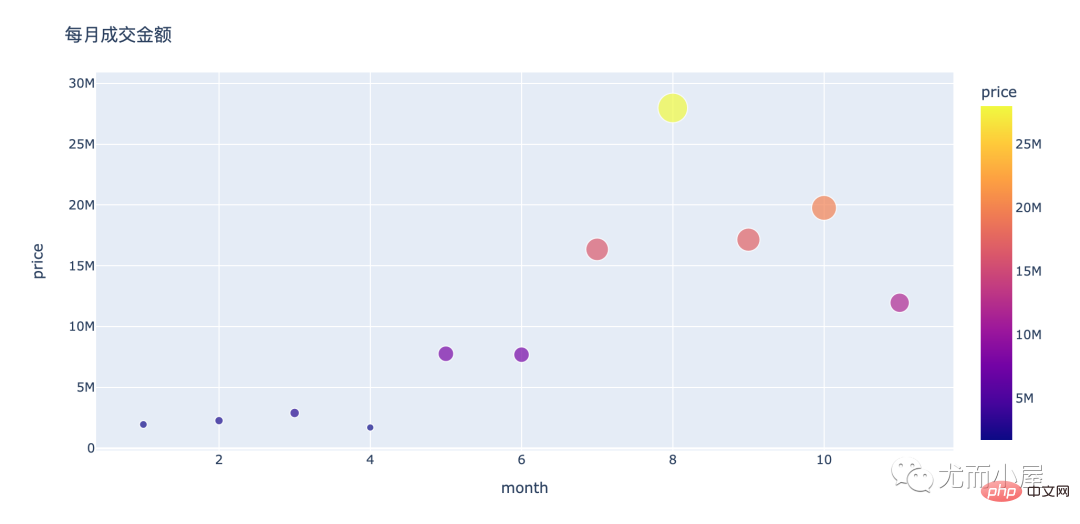
可以看到:
In [22]:
order_by_month = df.groupby("month")["order_id"].nunique().reset_index()
order_by_monthOut[22]:
month | order_id | |
0 | 1 | 10353 |
1 | 2 | 11461 |
2 | 3 | 12080 |
3 | 4 | 9001 |
4 | 5 | 30460 |
5 | 6 | 28978 |
6 | 7 | 57659 |
7 | 8 | 73897 |
8 | 9 | 345 |
9 | 10 | 14 |
10 | 11 | 6 |
In [23]:
fig = px.line(order_by_month,x="month",y="order_id") fig.update_layout(height=500, width=1000, title_text="每月成交订单量") fig.show()
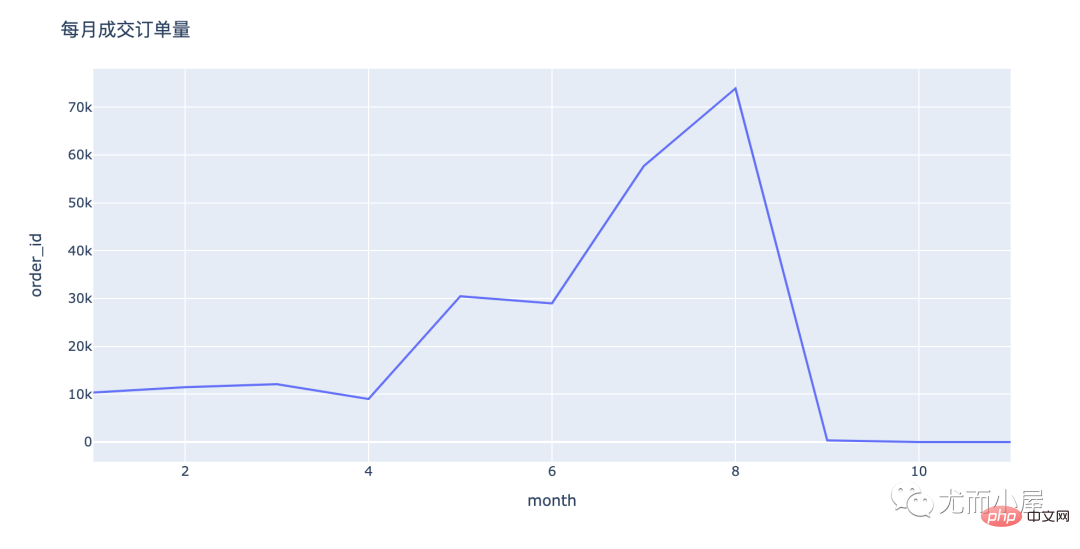
关于订单量:
In [24]:
# nunique:对每个user_id进行去重:消费人数
# count:统计user_id 的次数;消费人次(存在一人多次购买)
people_by_month = df.groupby("month")["user_id"].agg(["nunique","count"]).reset_index()
people_by_monthOut[24]:
month | nunique | count | |
0 | 1 | 1388 | 15575 |
1 | 2 | 1508 | 17990 |
2 | 3 | 1597 | 18687 |
3 | 4 | 1525 | 11867 |
4 | 5 | 3168 | 40332 |
5 | 6 | 3966 | 41355 |
6 | 7 | 5159 | 76415 |
7 | 8 | 6213 | 100006 |
8 | 9 | 5497 | 70496 |
9 | 10 | 4597 | 104075 |
10 | 11 | 3134 | 67332 |
In [25]:
fig = px.line(people_by_month,x="month",y="nunique") fig.update_layout(height=500, width=1000, title_text="每月成交人数") fig.show()
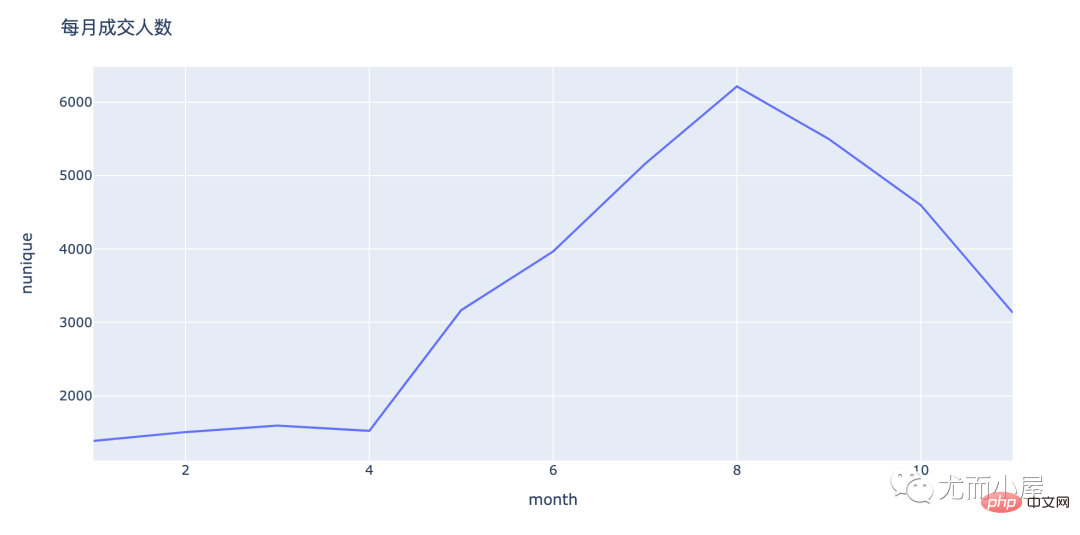
fig = px.line(people_by_month,x="month",y="count") fig.update_layout(height=500, width=1000, title_text="每月成交人次") fig.show()
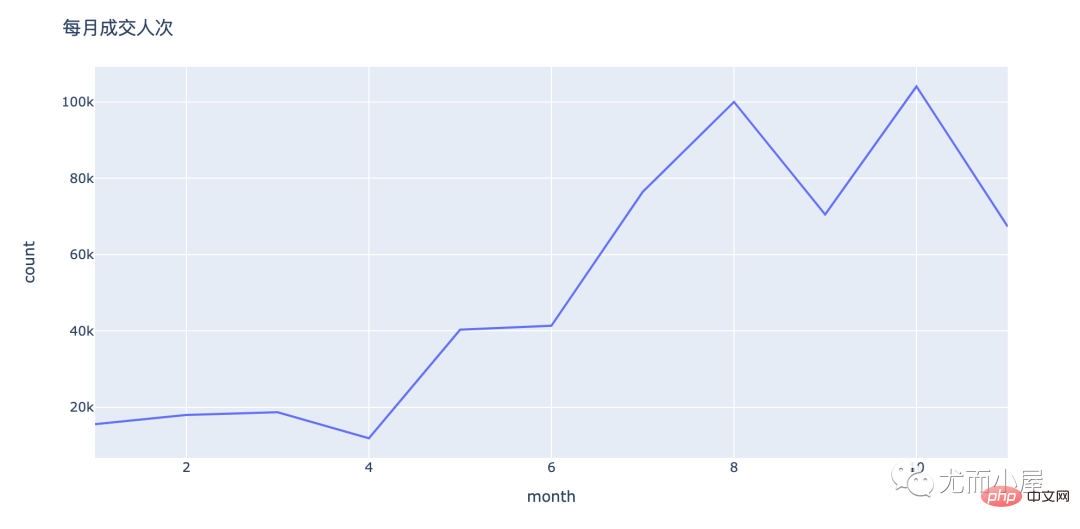
In [27]:
amount_by_month# 每月成交金额
Out[27]:
month | price | |
0 | 1 | 1953358.17 |
1 | 2 | 2267809.88 |
2 | 3 | 2897486.26 |
3 | 4 | 1704422.41 |
4 | 5 | 7768637.79 |
5 | 6 | 7691244.33 |
6 | 7 | 16354029.27 |
7 | 8 | 27982605.44 |
8 | 9 | 17152310.57 |
9 | 10 | 19765680.76 |
10 | 11 | 11961511.52 |
In [28]:
order_by_month# 每月订单数
Out[28]:
month | order_id | |
0 | 1 | 10353 |
1 | 2 | 11461 |
2 | 3 | 12080 |
3 | 4 | 9001 |
4 | 5 | 30460 |
5 | 6 | 28978 |
6 | 7 | 57659 |
7 | 8 | 73897 |
8 | 9 | 345 |
9 | 10 | 14 |
10 | 11 | 6 |
In [29]:
amount_by_userid = pd.merge(amount_by_month,order_by_month) amount_by_userid
Out[29]:
month | price | order_id | |
0 | 1 | 1953358.17 | 10353 |
1 | 2 | 2267809.88 | 11461 |
2 | 3 | 2897486.26 | 12080 |
3 | 4 | 1704422.41 | 9001 |
4 | 5 | 7768637.79 | 30460 |
5 | 6 | 7691244.33 | 28978 |
6 | 7 | 16354029.27 | 57659 |
7 | 8 | 27982605.44 | 73897 |
8 | 9 | 17152310.57 | 345 |
9 | 10 | 19765680.76 | 14 |
10 | 11 | 11961511.52 | 6 |
In [30]:
amount_by_userid["average"] = amount_by_userid["price"] / amount_by_userid["order_id"] amount_by_userid
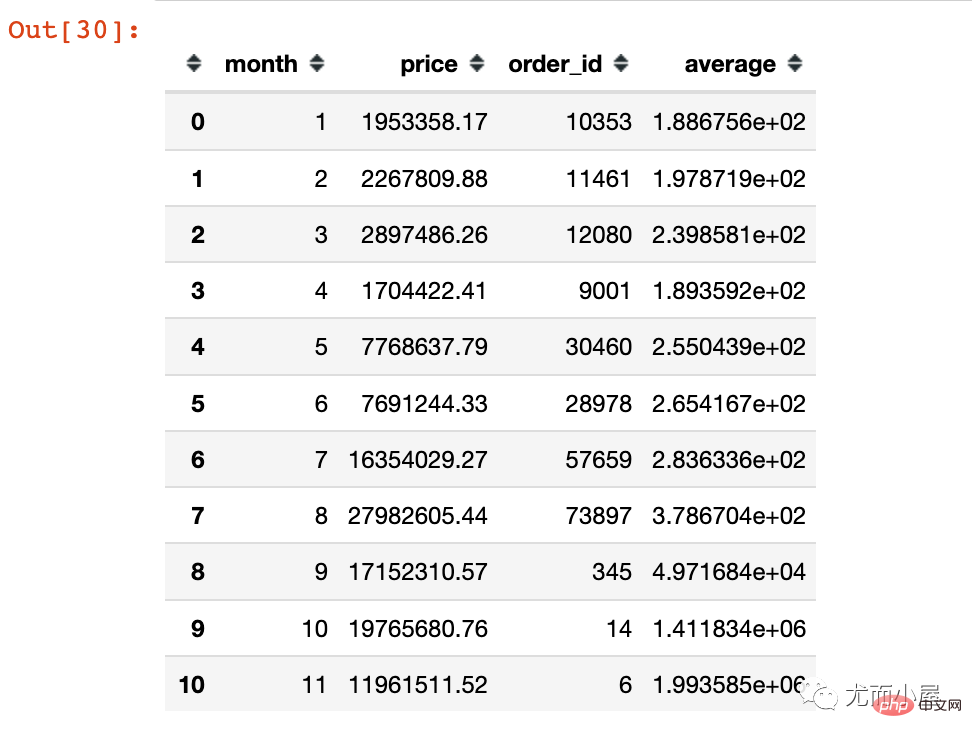
fig = px.line(amount_by_userid,x="month",y="average") fig.update_layout(height=500, width=1000, title_text="每月客单价") fig.show()
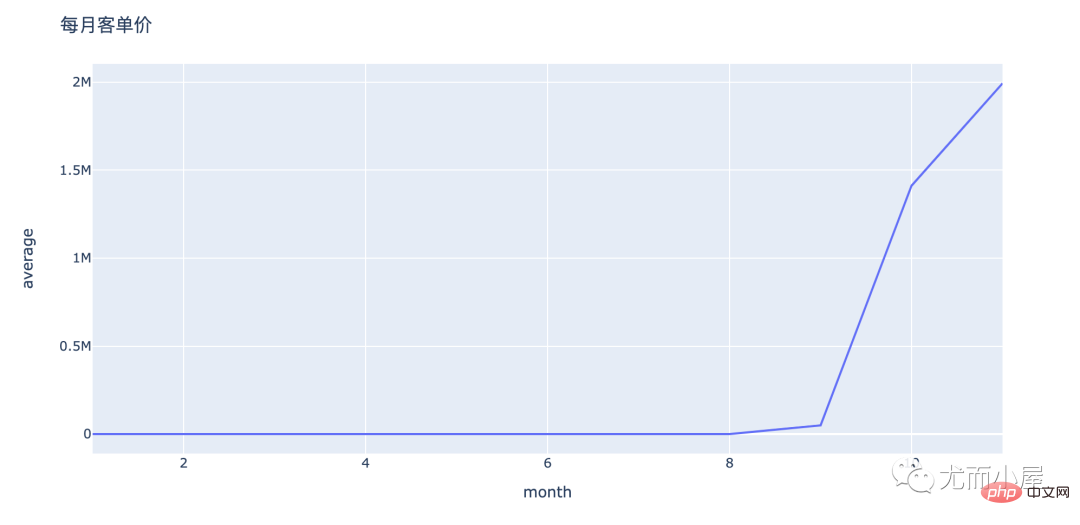
从上面的折线图可以看出来:
In [32]:
product_by_order = df.groupby("order_id")["product_id"].count().reset_index().sort_values("product_id",ascending=False)
product_by_order.head(10)Out[32]:
order_id | product_id | |
234208 | 2388440981134640000 | 15021 |
234210 | 2388440981134660000 | 14891 |
234211 | 2388440981134670000 | 14845 |
234212 | 2388440981134680000 | 14765 |
234202 | 2388440981134580000 | 14587 |
234205 | 2388440981134610000 | 14571 |
234207 | 2388440981134630000 | 14443 |
234204 | 2388440981134600000 | 14416 |
234206 | 2388440981134620000 | 14414 |
234203 | 2388440981134590000 | 14194 |
In [33]:
fig = px.bar(product_by_order[:20], x="order_id", y="product_id", text="product_id" ) fig.show()
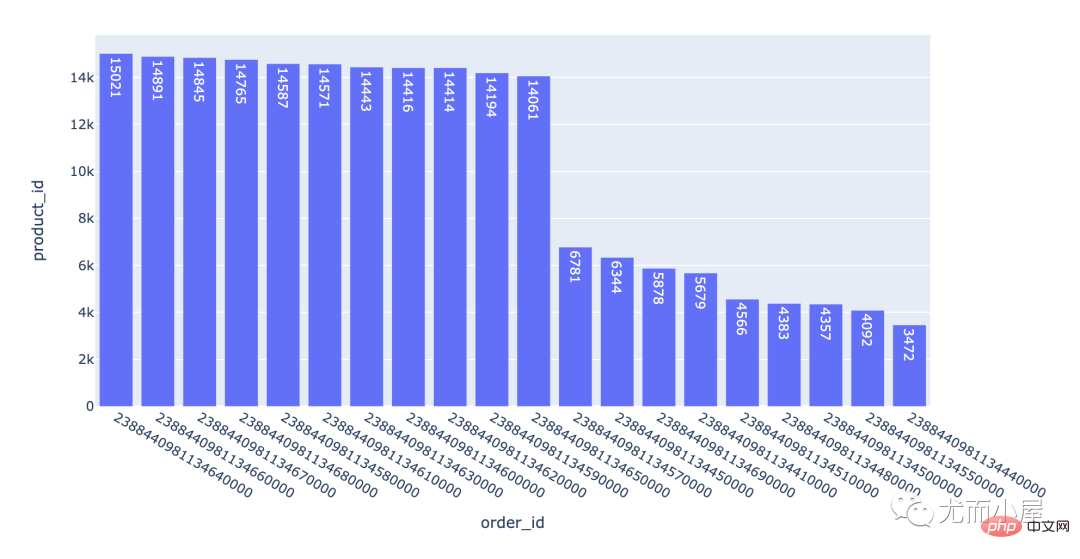
一个订单下包含的产品数量是不同;上万的订单可能是小型的ic元器件产品。
不同省份下的订单量、用户量和成交金额对比
In [34]:
local = df.groupby("local").agg({"order_id":"nunique","user_id":"nunique","price":sum}).reset_index()
local.head()Out[34]:
local | order_id | user_id | price | ||||||||||||||||||||||||||||||||||||||||||||||||||||||||||||||||||||||||||||||||||||||||||||||||||||||||||||||||||||
0 | 上海 | 39354 | 5680 | 19837942.20 | |||||||||||||||||||||||||||||||||||||||||||||||||||||||||||||||||||||||||||||||||||||||||||||||||||||||||||||||||||
1 | 北京 | 38118 | 5702 | 19137748.75 | |||||||||||||||||||||||||||||||||||||||||||||||||||||||||||||||||||||||||||||||||||||||||||||||||||||||||||||||||||
2 | Sichuan | 13396 | 3589 | 6770891.28 | |||||||||||||||||||||||||||||||||||||||||||||||||||||||||||||||||||||||||||||||||||||||||||||||||||||||||||||||||||
| ##3 | Tianjin | 13058 | 3497 | ##6433736.85||||||||||||||||||||||||||||||||||||||||||||||||||||||||||||||||||||||||||||||||||||||||||||||||||||||||||||||||||||
| Guangdong | 51471 | ##6085 | 26013770.86 |
local | order_id | user_id | price | ||||||||||||||||||||||||||||||||||||||||||||||||||||||||||
6 | 浙江 | 12790 | 3485 | 6522657.59 | |||||||||||||||||||||||||||||||||||||||||||||||||||||||||
8 | 湖北 | 12810 | 3488 | 5993820.57 | |||||||||||||||||||||||||||||||||||||||||||||||||||||||||
3 | 天津 | 13058 | 3497 | ##6433736.85 | |||||||||||||||||||||||||||||||||||||||||||||||||||||||||
| 10 | Chongqing | 13058 | 3496 | 6479488.14 | |||||||||||||||||||||||||||||||||||||||||||||||||||||||||
| 7 | Hainan | 13076 | 3587 | ##6968674.41||||||||||||||||||||||||||||||||||||||||||||||||||||||||||
| 四川 | ##13396 | 3589 | 6770891.28 | ||||||||||||||||||||||||||||||||||||||||||||||||||||||||||
| ##5 | 江苏 | 13575 | 3598 | ##6357286.87||||||||||||||||||||||||||||||||||||||||||||||||||||||||||
| Hunan | 13879 | 3481 | 6983078.88 | ||||||||||||||||||||||||||||||||||||||||||||||||||||||||||
| Beijing | 38118 | 5702 | ##19137748.75 | ##0 | 上海 | ##39354 | ##5680##19837942.20 | ||||||||||||||||||||||||||||||||||||||||||||||||||||||
| Guangdong | 51471 | 6085 | ##26013770.86 | In [36]: fig = px.pie(df1, names="local",labels="local",values="price") fig.update_traces( textpositinotallow="inside", textinfo="percent+label" ) fig.show() Copy after login
无疑:广东省No.1 每个省份的订单量对比: fig = px.bar(df1,x="order_id",y="local",orientatinotallow="h") fig.show() Copy after login
# 整体的可视化效果 fig = px.scatter_3d(local, x="order_id", y="user_id", z="price", color="order_id", hover_name="local" ) fig.show() Copy after login
通过3D散点图我们发现:广东省真的是一骑绝尘!
分析7:不同省份的客户钟爱哪些品牌?In [39]: local_brand = df.groupby(["local","brand"]).size().to_frame().reset_index() local_brand.columns = ["local","brand","number"]# 修改字段名 local_brand Copy after login
# 根据local和number进行排序
local_brand.sort_values(["local","number"],ascending=[True,False],inplace=True,ignore_index=True)
local_brand = local_brand[local_brand["brand"] != "missing"]
# 每个local下面最受欢迎的前3个品牌
local_brand = local_brand.groupby("local").head(3)
local_brandCopy after login
fig = px.bar(local_brand, x="brand", y="number", color="number", facet_col="local") fig.update_layout(height=500,width=1000) fig.show() Copy after login
看来大家都很喜欢: samsung 、apple、ava 不同时间对比分析8:下单时间对比In [43]: df.columns Copy after login Out[43]: Index(['event_time', 'order_id', 'product_id', 'category_id', 'category_code', 'brand', 'price', 'user_id', 'age', 'sex', 'local', 'month', 'day', 'dayofweek', 'hour'], dtype='object') Copy after login In [44]: df2 = df.groupby("dayofweek")["order_id"].nunique().reset_index()
df2Copy after login Out[44]:
In [45]: plt.figure(figsize=(12,7))
df2["order_id"].plot.bar()
plt.xticks(range(7),['周一','周二','周三','周四','周五','周六','周日'],rotatinotallow=0)
plt.xlabel('星期')
plt.ylabel('订单量')
plt.title('订单数随星期变化')
plt.show()Copy after login
分析9:每小时订单量In [46]: df3 = df.groupby("hour")["order_id"].nunique().reset_index()
df3.head(10)Copy after login Out[46]:
In [47]: plt.figure(figsize=(14,8))
df3["order_id"].plot()
plt.xlabel('小时')
plt.ylabel('订单数量')
plt.title('订单随小时数变化')
plt.grid()
plt.show()Copy after login
用户都喜欢在上午8、9、10点下单;可能是刚开始上班工作,大家更积极 不同用户消费行为分析分析10:消费次数和消费金额In [48]: df4 = df.groupby("user_id").agg({"order_id":"nunique", "price":sum})
fig = px.scatter(df4,
x="order_id",
y="price",
color="price",
size="price")
fig.show()Copy after login
分析11:用户消费周期In [50]: # 用户消费周期
# shift函数:移动一个单位
purchase_time=df.groupby('user_id').apply(lambda x: x['event_time'] - x['event_time'].shift()).dt.days
purchase_timeCopy after login Out[50]: user_id 151591562543995000096014NaN 1515915625440030000374760 NaN 48492735.0 1515915625440050000463812 NaN 473430 1.0 ... 1515915625514880000564132 0.0 564143 0.0 564164 0.0 1515915625514890000564158 NaN 564165 0.0 Name: event_time, Length: 564130, dtype: float64 Copy after login In [51]: purchase_time[purchase_time>0].describe() Copy after login Out[51]: count120629.000000 mean 35.494500 std 663.803583 min 1.000000 25% 2.000000 50% 4.000000 75%12.000000 max 18466.000000 Name: event_time, dtype: float64 Copy after login 说明:
分析12:用户复购行为In [52]: pivoted_counts = df.pivot_table(index='user_id', columns='month', values='order_id', aggfunc='nunique').fillna(0) pivoted_counts Copy after login Out[52]:
pivoted_counts_map.sum() / pivoted_counts_map.count() # 结果 month 1 0.406340 2 0.439655 3 0.474640 4 0.700328 5 0.829861 6 0.792990 7 0.891452 8 0.920328 9 0.781153 100.609963 110.419592 dtype: float64 Copy after login (pivoted_counts_map.sum()/pivoted_counts_map.count()).plot(figsize=(12,6))
plt.xticks(range(11),columns_month)
plt.title('复购率')
plt.show()Copy after login
The above is the detailed content of E-commerce data mining based on machine learning | Data exploration. For more information, please follow other related articles on the PHP Chinese website!
Related labels:
Previous article:The secret weapon to improve the prediction quality of deep learning models—context-aware data
Next article:Microsoft shares the development story of the new version of Bing: I was so impressed by the ChatGPT demo that I immediately decided to integrate it into Bing
Statement of this Website
The content of this article is voluntarily contributed by netizens, and the copyright belongs to the original author. This site does not assume corresponding legal responsibility. If you find any content suspected of plagiarism or infringement, please contact admin@php.cn
Latest Articles by Author
Latest Issues
Team collaboration - What should I do if someone needs the feature I wrote as a dependency in git flow?
From 1970-01-01 08:00:00
0
0
0
Confusion about using gitlab's fork&pull request mode within the team
From 1970-01-01 08:00:00
0
0
0
Related Topics
More>
Popular Recommendations
Popular Tutorials
More>
Latest Downloads
More>
|